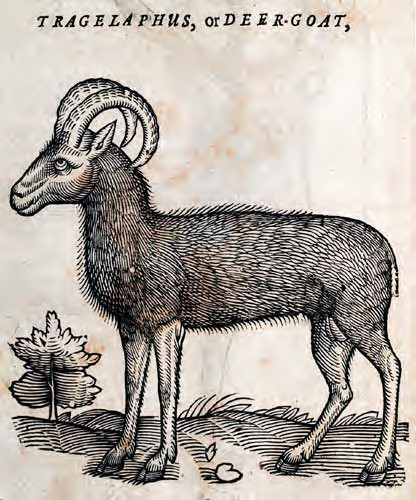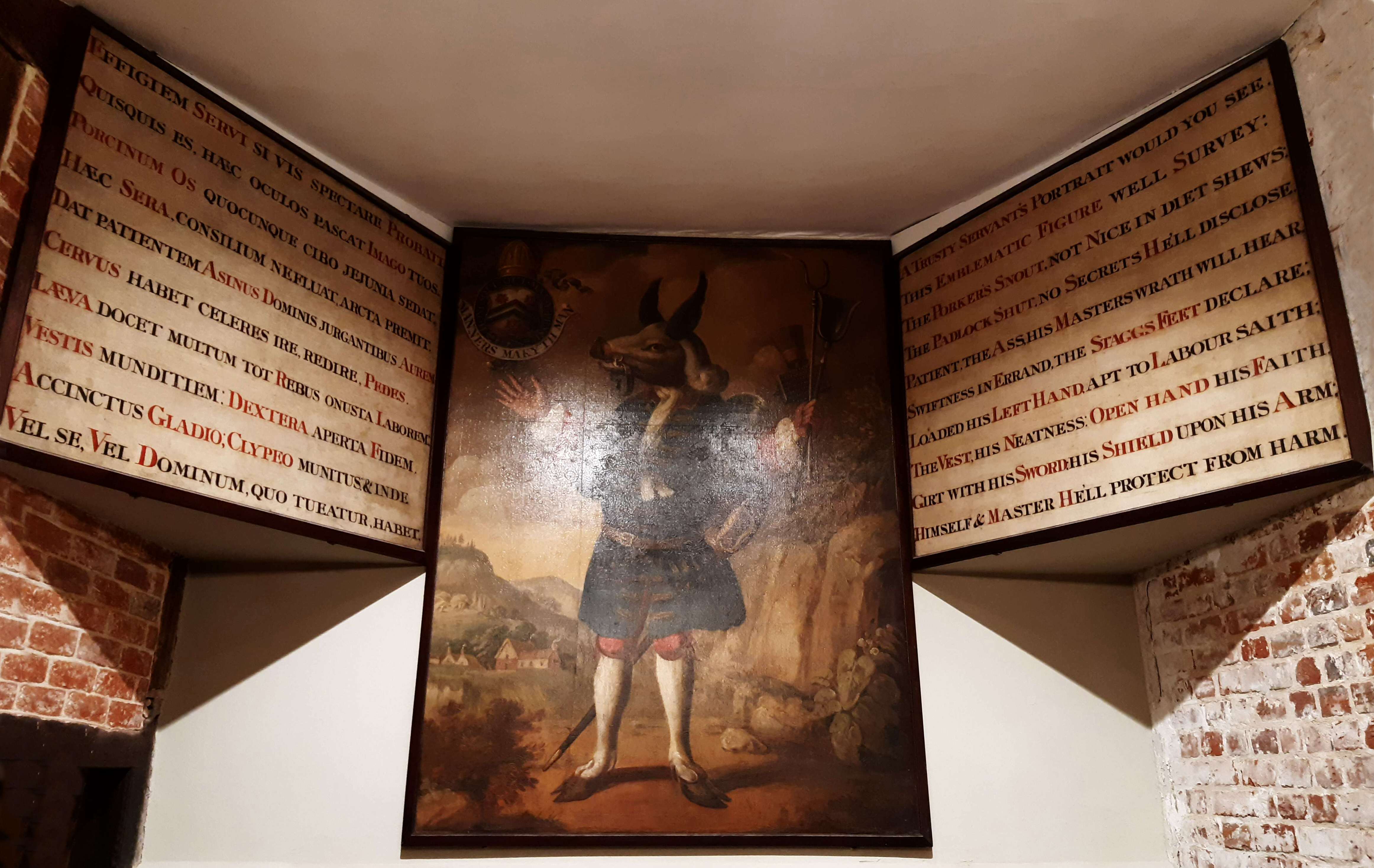|
Hircocervus
The hircocervus (, "billy goat" + ''cervus'', "stag") or tragelaph (, "billy goat" + έλαφος, ''elaphos'', "stag"), also known as a goat-stag, was a legendary creature imagined to be half-goat, half-stag. Origins In Plato's ''Republic'', Socrates speaks of his own image-making as similar to that of painters who paint goat-stags, combining the features of different things together (488a). In his work ''De Interpretatione'', Aristotle utilized the idea of a fabulous goat-stag to express the philosophical concept of something that is describable even though it does not really exist. His Greek "τραγέλαφος" was rendered into Latin "hircocervus" by Boethius. Aristotle returned to this in the ''Posterior Analytics'' to argue that, though the word is definable, there can be no definition of the species as it has no members. He also uses the ''tragelaphos'' together with the Sphinx in the Physics to illustrate the point that a non-existent creature has no spatial locati ... [...More Info...] [...Related Items...] OR: [Wikipedia] [Google] [Baidu] |
The Trusty Servant
The Trusty Servant is an emblematic figure in a painting at Winchester College and the name of the college's alumni magazine. The wall-painting called ''The Trusty Servant'' was painted by John Hoskins (poet), John Hoskins in 1579. It was reworked by William Cave in 1809, giving the painting now on display there. It hangs outside the college's kitchen. The American author Arthur Cleveland Coxe (1818-1896) described "the time-honoured ''Hircocervus'', or picture of 'the Trusty-servant,' which hangs near the kitchen, and which emblematically sets forth those virtues in domestics, of which we Americans know nothing. It is a figure, part man, part porker, part deer, and part donkey; with a padlock on his mouth, and various other symbols in his hands and about his person, the whole signifying a most valuable character." The painting of ''The Trusty Servant'' had a didactic function: it is accompanied by allegorical verses that associate the servant's various animal parts with distin ... [...More Info...] [...Related Items...] OR: [Wikipedia] [Google] [Baidu] |
Winchester Trusty Servant 2
Winchester (, ) is a cathedral city in Hampshire, England. The city lies at the heart of the wider City of Winchester, a local government district, at the western end of the South Downs National Park, on the River Itchen. It is south-west of London and from Southampton, its nearest city. At the 2021 census, the built-up area of Winchester had a population of 48,478. The wider City of Winchester district includes towns such as Alresford and Bishop's Waltham and had a population of 127,439 in 2021. Winchester is the county town of Hampshire and contains the head offices of Hampshire County Council. Winchester developed from the Roman town of Venta Belgarum, which in turn developed from an Iron Age ''oppidum''. Winchester was one of if not the most important cities in England until the Norman Conquest in the eleventh century. It now has become one of the most expensive and affluent areas in the United Kingdom. The city's major landmark is Winchester Cathedral. The city is also ... [...More Info...] [...Related Items...] OR: [Wikipedia] [Google] [Baidu] |
Medieval European Legendary Creatures
In the history of Europe, the Middle Ages or medieval period lasted approximately from the 5th to the late 15th centuries, similarly to the post-classical period of global history. It began with the fall of the Western Roman Empire and transitioned into the Renaissance and the Age of Discovery. The Middle Ages is the middle period of the three traditional divisions of Western history: classical antiquity, the medieval period, and the modern period. The medieval period is itself subdivided into the Early, High, and Late Middle Ages. Population decline, counterurbanisation, the collapse of centralised authority, invasions, and mass migrations of tribes, which had begun in late antiquity, continued into the Early Middle Ages. The large-scale movements of the Migration Period, including various Germanic peoples, formed new kingdoms in what remained of the Western Roman Empire. In the 7th century, North Africa and the Middle East—once part of the Byzantine Empire—came un ... [...More Info...] [...Related Items...] OR: [Wikipedia] [Google] [Baidu] |
Antonio Gramsci
Antonio Francesco Gramsci ( , ; ; 22 January 1891 – 27 April 1937) was an Italian Marxist philosophy, Marxist philosopher, Linguistics, linguist, journalist, writer, and politician. He wrote on philosophy, Political philosophy, political theory, sociology, history, and linguistics. He was a founding member and one-time leader of the Italian Communist Party. A vocal critic of Benito Mussolini and fascism, he was imprisoned in 1926, and remained in prison until shortly before his death in 1937. During his imprisonment, Gramsci wrote more than 30 notebooks and 3,000 pages of history and analysis. His ''Prison Notebooks'' are considered a highly original contribution to 20th-century political theory. Gramsci drew insights from varying sources—not only other Marxists but also thinkers such as Niccolò Machiavelli, Vilfredo Pareto, Georges Sorel, and Benedetto Croce. The notebooks cover a wide range of topics, including the history of Italy and Italian nationalism, the French Rev ... [...More Info...] [...Related Items...] OR: [Wikipedia] [Google] [Baidu] |
Marxist
Marxism is a political philosophy and method of socioeconomic analysis. It uses a dialectical and materialist interpretation of historical development, better known as historical materialism, to analyse class relations, social conflict, and social transformation. Marxism originates from the works of 19th-century German philosophers Karl Marx and Friedrich Engels. Marxism has developed over time into various branches and schools of thought, and as a result, there is no single, definitive " Marxist theory". Marxism has had a profound effect in shaping the modern world, with various left-wing and far-left political movements taking inspiration from it in varying local contexts. In addition to the various schools of thought, which emphasize or modify elements of classical Marxism, several Marxian concepts have been incorporated into an array of social theories. This has led to widely varying conclusions. Alongside Marx's critique of political economy, the defining ... [...More Info...] [...Related Items...] OR: [Wikipedia] [Google] [Baidu] |
Invisible Cities
''Invisible Cities'' () is a postmodern novel by Italian writer Italo Calvino. It was published in Italy in 1972 by Giulio Einaudi Editore. Description The book is framed as a conversation between the Mongol emperor Kublai Khan, and Marco Polo. The majority of the book consists of brief prose poems describing 55 fictitious cities that are narrated by Polo, many of which can be read as commentary on culture, language, time, memory, death, or human experience generally. Short dialogues between Kublai and Polo are interspersed every five to ten cities discussing the same topics. These interludes between the two characters are no less poetically constructed than the cities, and form a framing device that plays with the natural complexity of language and stories. In the middle of the book, Kublai asks about a city Polo never mentioned, his hometown of Venice. Polo replied, "Every time I describe a city I am saying something about Venice." Historical background ''Invisible Citie ... [...More Info...] [...Related Items...] OR: [Wikipedia] [Google] [Baidu] |
Italo Calvino
Italo Calvino (, ; ;. RAI (circa 1970), retrieved 25 October 2012. 15 October 1923 – 19 September 1985) was an Italian novelist and short story writer. His best-known works include the ''Our Ancestors'' trilogy (1952–1959), the '' Cosmicomics'' collection of short stories (1965), and the novels '' Invisible Cities'' (1972) and ''If on a winter's night a traveler'' (1979). Admired in Britain, Australia and the United States, Calvino was the most translated contemporary Italian writer at the time of his death. He is buried in the garden cemetery of Castiglione della Pescaia in Tuscany. Biography Parents Italo Calvino was born in Santiago de las Vegas, a suburb of Havana, Cuba, in 1923. His father, , was a tropical agronomist and botanist who also taught agriculture and floriculture. Born 47 years earlier in Sanremo, Italy, Mario Calvino had emigrated to Mexico in 1909 where he took up an important position with the Ministry of Agriculture. In an autobiographical e ... [...More Info...] [...Related Items...] OR: [Wikipedia] [Google] [Baidu] |
The Island Of The Day Before
''The Island of the Day Before'' () is a 1994 historical fiction novel by Umberto Eco set in the 17th century during the historical search for the secret of longitude. The central character is Roberto della Griva, an Italian nobleman stranded on a deserted ship in the Pacific Ocean, and his slowly decaying mental state, in a backdrop of Baroque-era science, metaphysics, and cosmology. Plot summary Roberto della Griva, a 17th-century Italian nobleman, is the sole survivor of a shipwreck during a fierce storm. He finds himself washed up on an abandoned ship, the ''Daphne'', anchored off a mysterious Pacific island through which, he convinces himself, runs the International Date Line (roughly 180° longitude). The ship is fully provisioned, he discovers, but the crew is missing. Although the shore is very close, Roberto is unable to swim, and is therefore stranded on the ship. With no way of locating himself or finding a way home, Roberto abandons himself to philosophical contempla ... [...More Info...] [...Related Items...] OR: [Wikipedia] [Google] [Baidu] |
Umberto Eco
Umberto Eco (5 January 1932 – 19 February 2016) was an Italian Medieval studies, medievalist, philosopher, Semiotics, semiotician, novelist, cultural critic, and political and social commentator. In English, he is best known for his popular 1980 novel ''The Name of the Rose'', a historical mystery combining semiotics in fiction with biblical analysis, medieval studies and literary theory, as well as ''Foucault's Pendulum'', his 1988 novel which touches on similar themes. Eco wrote prolifically throughout his life, with his output including children's books, translations from French and English, in addition to a twice-monthly newspaper column "La Bustina di Minerva" (Minerva's Matchbook) in the magazine ''L'Espresso'' beginning in 1985, with his last column (a critical appraisal of the Romanticism, Romantic paintings of Francesco Hayez) appearing 27 January 2016. At the time of his death, he was an Emeritus professor at the University of Bologna, where he taught for much of hi ... [...More Info...] [...Related Items...] OR: [Wikipedia] [Google] [Baidu] |
Arthur Cleveland Coxe
Arthur Cleveland Coxe (May 10, 1818 – July 20, 1896) was the second Episcopal bishop of Western New York. He used Cleveland as his given name and is often referred to as A. Cleveland Coxe. Biography He was the son of the Reverend Samuel Hanson Cox and Abiah Hyde Cox ''née'' ''Cleveland'', but changed the spelling of the family name. He was born at Mendham, New Jersey, May 10, 1818. On his mother's side he was a grandson of the Rev. Aaron Cleveland, an early poet of Connecticut. His parents moved to New York in 1820, and he received his education there. Coxe was prepared for college under the private tuition of Professor George Bush. He entered the University of the City of New York, and graduated in 1838. During his freshman year he wrote a poem, ''The Progress of Ambition'', and in 1837 published ''Advent, a Mystery'', a poem after the manner of the religious dramas of the Middle Ages. In 1838 appeared ''Athwold, a Romaunt'', and ''Saint Jonathan, the Lay of the Scald' ... [...More Info...] [...Related Items...] OR: [Wikipedia] [Google] [Baidu] |





